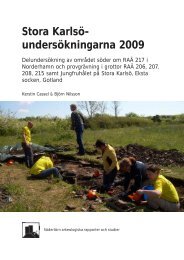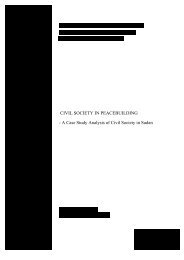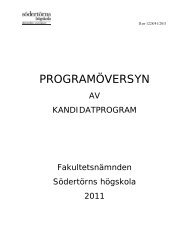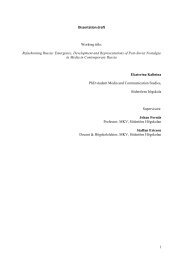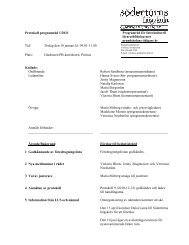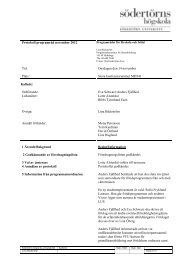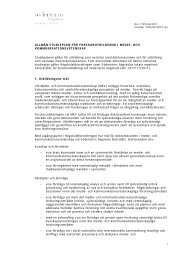Underlying Reasons for the Persistence of Female Genital Mutilation
Underlying Reasons for the Persistence of Female Genital Mutilation
Underlying Reasons for the Persistence of Female Genital Mutilation
Create successful ePaper yourself
Turn your PDF publications into a flip-book with our unique Google optimized e-Paper software.
core problem and take measures from <strong>the</strong>re. In this particular situation one <strong>of</strong> <strong>the</strong> problems<br />
addressed was <strong>the</strong> women per<strong>for</strong>ming FGM, called Ngariba. Families would pay <strong>the</strong> Ngaribas to<br />
circumcise <strong>the</strong>ir daughters, and as <strong>the</strong>y had authority to do this procedure, it also became a<br />
livelihood <strong>for</strong> <strong>the</strong>m. What AFENT started with was to educate <strong>the</strong> Ngaribas and compensate <strong>for</strong><br />
<strong>the</strong>ir livelihood.<br />
Ngariba from Sigino Village<br />
The tradition <strong>of</strong> FGM was very important in <strong>the</strong> village <strong>of</strong> Sigino. The <strong>for</strong>mer Ngariba explained<br />
that it was seen as a “declaration” <strong>for</strong> women, as well as it was an assurance <strong>for</strong> men that <strong>the</strong><br />
woman he would marry had not been with o<strong>the</strong>r men be<strong>for</strong>e him. According to her it was an<br />
equally important practice <strong>for</strong> men since a circumcised girl was a marriageable girl. She became<br />
a Ngariba through heritage, her grandmo<strong>the</strong>r and her mo<strong>the</strong>r use to be one. When she was<br />
per<strong>for</strong>ming FGM <strong>the</strong> families would bring gifts and pay around 200 shilling to have <strong>the</strong>ir<br />
daughters circumcised, and <strong>the</strong> procedure would take place in a distance from <strong>the</strong> village. She<br />
stopped being a Ngariba when she got educated and do not regret this decision, but <strong>the</strong> primary<br />
reason was that she was concerned <strong>for</strong> her daughter’s health. The pain that she suffered when she<br />
had undergone FGM, she did not want her daughter to experience.<br />
The education <strong>the</strong> <strong>for</strong>mer Ngariba got from AFNET, and <strong>the</strong> concern <strong>for</strong> her daughter’s health<br />
was enough <strong>for</strong> her to stop, however she thinks that in order <strong>for</strong> <strong>the</strong> practice to truly disappear<br />
<strong>the</strong> villages and <strong>the</strong> people need to be alert <strong>of</strong> what goes on in <strong>the</strong>ir surroundings.<br />
Fatima, adolescent from Babati Town 64<br />
Fatima is an orphan currently living in Babati in a Muslim orphanage in Babati Town. Fatima<br />
was born in Babati Town but moved to Kondoa to live with her grandmo<strong>the</strong>r when she was a<br />
little girl. According to AFNET, Kondoa, which is located in Dodoma region not far from<br />
Babati, is one <strong>of</strong> <strong>the</strong> areas where AFNET operates and have to some extent succeeded. There are<br />
however records found <strong>of</strong> girls and women that still have undergone FGM. Often it is in rural<br />
areas that are isolated and difficult to reach where <strong>the</strong> practice <strong>of</strong> FGM occurs. Fatima was about<br />
64 Fatima is a fictive name <br />
26



